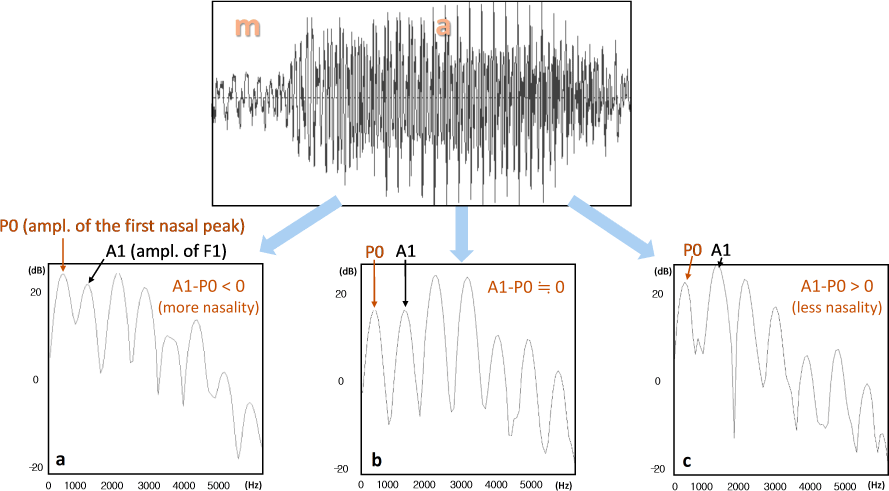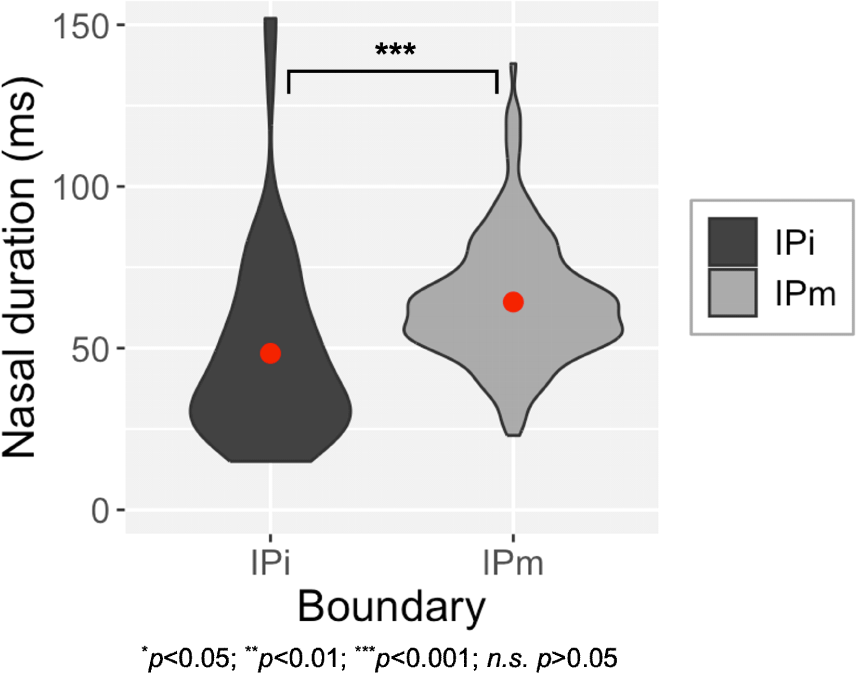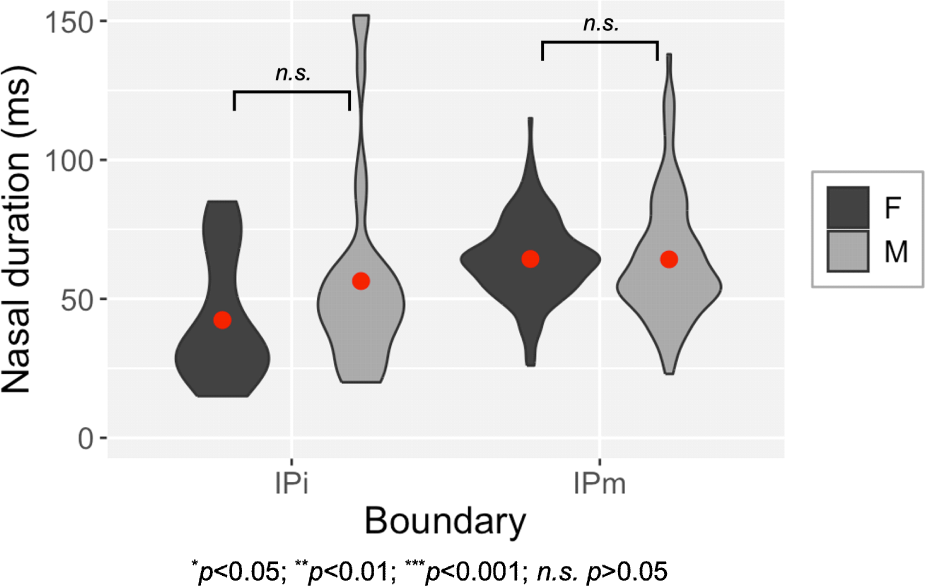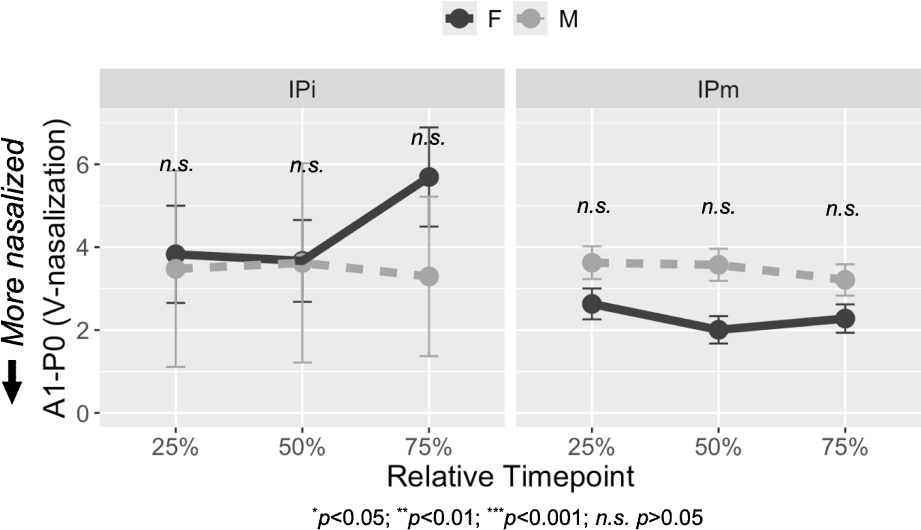1. Introduction
Recent studies have documented an ongoing sound change in Seoul Korean, characterized by the extreme reduction of word-initial nasal consonants, particularly at higher prosodic boundaries (Jang et al., 2018; Lee et al., 2023; Yoo & Nolan, 2020; Yoshida, 2008). This denasalization phenomenon aligns with a cross-linguistic tendency for nasal consonants to weaken in phrase-initial positions (English: Cho & Keating, 2009; Cho et al., 2017; Korean: Cho & Keating, 2001; French: Fougeron, 2001; Jang et al., 2018; Mandarin Chinese: Li et al., 2020). Such boundary-related modifications reflect domain-initial strengthening, which increases the articulatory force of oral gestures, raising the velum and consequently reducing nasality (Cho & Keating, 2001; Fougeron & Keating, 1997; Keating et al., 2004).
In Seoul Korean, where nasality reduction is more extreme than in other languages, it has been argued that a prosodically conditioned phonetic variation has potentially developed into a systematic sound change (Jang et al., 2018; Lee et al., 2023; Yoo & Nolan, 2020). As an edge-prominence language that marks prominence primarily through phrasing rather than lexical stress (Jun, 2005), Seoul Korean exhibits notably strong domain-initial strengthening effects compared to languages like English (Cho, 2016, 2022; Keating et al., 2004), which encode prominence through lexically defined heads. This heightened sensitivity to boundary marking appears to have reinforced domain-initial strengthening of oral articulation, inducing an extreme reduction of nasality to the point where the nasal quality of phrase-initial nasal consonants has become perceptually ambiguous (Yoo & Nolan, 2020) or often inaudible (Yoshida, 2008), potentially laying the groundwork for a sound change toward denasalization.
In the present study, we extend the investigation of the putative denasalization sound change to another Korean dialect, North Gyeongsang (NG; Kyungsang) Korean (henceforth NG Korean). This dialectal comparison is valuable from two perspectives. First, it provides insights into the patterns of sound change across Korean dialects. Previous evidence of the ongoing Voice Onset Time (VOT) merger, in which the primary VOT cue distinguishing lenis and aspirated stops is merging and being replaced by an F0 cue, suggests that Seoul Korean leads this sound change (cf. Kang, 2014; Lee & Jongman, 2012). Younger Gyeongsang speakers have been reported to gradually adopt Seoul-like patterns while retaining some traditional features (Lee & Jongman, 2016). In addition, among Seoul Korean speakers, female speakers have been found to lead the VOT merger (Lee & Jongman, 2012; Oh, 2010), consistent with the broader tendency for female speakers to drive linguistic innovation (Kendall et al., 2023; Labov, 1973).
However, regarding denasalization, Lee et al. (2023) report an opposite pattern in Seoul Korean, as shown in Figure 1, a finding further corroborated by our recent study (Jang et al., under review). Their results suggest that, while both female and male Seoul speakers exhibit comparable reductions in the duration of nasal murmur during phrase-initial nasal consonants, male speakers provide stronger evidence for denasalization, as reflected in the reduced coarticulatory nasalization of the following vowel. In contrast, female speakers tend to maintain nasality in the vowel, despite the nasal consonant being reduced to the same extent as in male speakers. This pattern has been interpreted as female speakers preserving nasality to maintain phonological contrast (cf. Oh, 2010) and/or reflecting a possible social meaning associated with nasality, which may influence gendered speech patterns. Notably, in some East Asian speech communities, female speakers have been observed to favor nasalized speech (Endo, 2008; Yueh, 2016).

Given this context, we extend our investigation of position-dependent denasalization across genders to NG Korean. This not only allows us to document a potential denasalization process in a dialect other than Seoul Korean but also provides insight into the possible progression of denasalization across dialects as an ongoing sound change, examined in conjunction with gender as a sociolinguistic factor.
A comparison between Seoul and NG Korean also offers a unique perspective on how distinct prosodic systems shape the denasalization process. As noted earlier, Seoul Korean, an edge-prominence language, lacks lexical prosodic specifications and instead marks prominence through prosodic boundaries (Jun, 2005), which may account for its extreme domain-initial nasal reduction. In contrast, NG Korean exhibits a more complex prosodic system, classified as a head/edge-prominence language due to its combination of lexical pitch accent and phrase-level tones, similar to Tokyo Japanese (Cho et al., 2019; cf. Jun, 2014; Jun et al., 2006). NG Korean employs word-level tonal contrasts, where lexical pitch accent plays a crucial phonological role in distinguishing lexical meanings (Jun et al., 2006). Since lexical pitch accent can influence the phonetic realization of segmental properties, its interaction with domain- initial strengthening warrants consideration. Although our study does not specifically examine pitch accent patterns due to speech material limitations (see Section 2.2), the presence of a pitch accent system raises important questions about its potential role in domain-initial strengthening.
Domain-initial strengthening in Japanese has been reported to be less robust than in Seoul Korean (Onaka, 2003), possibly due to competing demands between maintaining tonal contrasts and implementing domain-initial strengthening in its lexical pitch accent system. Similarly, NG Korean may exhibit weaker domain-initial strengthening patterns due to its prosodic structure, which is comparable to that of Japanese. If so, this may result in weaker nasal reduction and a higher degree of vowel nasalization, providing insight into the progression of denasalization as a potential ongoing sound change in NG Korean. This, in turn, may be reflected in whether the gender effect observed in Seoul Korean, where the denasalization process is more advanced in male speakers, is also present in NG Korean. In Seoul Korean, female speakers tend to maintain greater nasality than male speakers. If NG Korean exhibits overall weaker nasal reduction, the gender difference may also be less pronounced, a possibility explored in the present study. Importantly, to compare the results of the current study on NG Korean with those of Seoul Korean (Lee et al., 2023), we use the same speech materials as in the Seoul Korean studies (see Section 2 for the details of these speech materials).
2. Methodology
The current study utilized a dataset from an acoustic-articulatory database for Korean (Korean Dynamic Articulatory Database, K-DAD), currently under development at the Hanyang Institute for Phonetics and Cognitive Sciences of Language (HIPCS, 2022). Speech data from 26 native NG Korean speakers (female: 13, male: 13; mean age=20.4, age range=19–23) were examined, all of whom were born and raised in the NG region at least until after high school graduation. Acoustic recordings were conducted in a soundproof room using a Tascam HC-P2 digital recorder and a SHURE KSN44 condenser microphone, with a sampling rate of 44 kHz. Additionally, articulatory data were collected using an Electromagnetic Articulograph (AG501, Carstens Medizinelektronik GmbH, Bovenden, Germany), but only the acoustic data were analyzed for the purpose of the present study.
As introduced earlier, we selected a passage from the K-DAD corpus (HIPCS, 2022) describing a bakery competition between two shops with disyllabic names: /mami/ and /mima/, both beginning with nasal consonants. However, because the high vowel in /mima/ has a first formant frequency close to the first nasal peak (typically between 250 and 450 Hz), our analysis of vowel nasalization was restricted to the low vowel context /ma/ in /mami/ to ensure a clearer assessment of the nasal consonant’s influence on the following vowel. For the analysis of consonantal nasal duration, we reported nasal duration data for /mami/ to be matched with the vowel nasalization analysis, along with a separate analysis including /mima/ to examine whether the boundary effect on nasal duration varies depending on the vowel context. It is also worth noting that the nasal consonant in the second syllable of /mami/ could influence the preceding vowel through anticipatory coarticulatory nasalization. Nevertheless, our study prioritizes the examination of carryover nasalization from the initial syllable’s onset consonant, as our primary objective is to investigate the denasalization of word-initial nasals.
The passage was designed to elicit the target names under different prosodic boundary conditions (Table 1). To create phrase-initial contexts, the target words followed an adverbial phrase, naturally prompting speakers to produce a phrase boundary. In this study, we consider IP-initial and IP-medial conditions to compare our results with those of Seoul speakers, as reported in Lee et al. (2023). The prosodic boundary contexts of each token were verified and categorized by the authors, resulting in 54 IP-initial tokens, and 518 IP-medial tokens. Note that because the disyllabic names were created as shop names, they are not associated with any predefined lexical pitch accent patterns in NG Korean. As a result, speakers produced them with various pitch accent patterns, appearing as HL, LH, or HH. Due to this pitch accent variation within and across speakers, and also due to the small number of IP-initial tokens, we could not further analyze the data by pitch accent type, leaving any possible effects of pitch accent patterns for future studies.
Following the approach used in Cho et al. (2017) and Lee et al. (2023), two measurements were used. First, the duration of the nasal consonant murmur was measured by examining the onset and the offset of nasal energy and nasal zeros on the spectrogram (Figure 2). Along with this, we assessed vowel nasality by analyzing A1-P0 values during vowel articulation to quantify the degree of nasalization. A1-P0 refers to the amplitude difference between the first formant (A1) and the nasal spectral peak (P0), which typically falls within the 250–450 Hz range.

A1-P0 values were extracted at three relative time points within the vowel (25%, 50%, and 75%) using a Praat script developed by Styler (2017).1 These measurements allowed us to examine the spread of coarticulatory nasalization throughout the vowel, capturing its progression beyond the immediate influence of the nasal consonant. Notably, A1-P0 values are inversely related to nasalization, with lower values indicating greater nasalization.
The retrieved data were analyzed by linear mixed-effects analysis using lmerTest package (Kuznetsova et al., 2017) in R (R Core Team, 2024). The dependent variables were nasal duration (in ms) and vowel nasalization (as measured by A1-P0, in dB). The independent variables were Boundary (IPi, IPm), Gender (F, M) and their interaction. For the vowel nasalization model, an additional independent variable, Timepoint (25%, 50%, 75%), was added. Note that the primary focus is not on the main effect of Timepoint on A1-P0 but rather on its interaction with other factors (Boundary and Gender), as this could provide insight into how prosodic effects develop throughout the vowel’s duration. Boundary and Gender was contrast-coded as 0.5 and –0.5. Reference level for Timepoint was set as 25% point.
For all models, we employed a maximal random effects structure, as recommended by Barr et al. (2013), including by-speaker intercepts and slopes for the fixed effects, provided the models successfully converged. If convergence issues arose, we incrementally simplified the random slopes by removing those with the least variance, using model comparison techniques (i.e., Likelihood Ratio Tests) to guide the process.
Given that a key research question in this study is how position-driven nasal reduction influences coarticulatory vowel nasalization across genders, we examined the interaction between Boundary and Gender, and conducted planned paired comparisons for exploratory purposes to examine potential trends across boundary conditions and gender groups, regardless of the significance of the interaction. The paired comparisons were conducted using the emmeans package (Lenth, 2023).
3. Results
Statistical results on nasal duration are summarized in Figures 3 and 4. As shown in Figure 3, there is a significant main effect of Boundary on nasal duration (β=–13.889, SE=2.228, t=–7.131, p<0.001), with shorter durations in IP-initial than in IP-medial positions. This pattern aligns with the cross-linguistically observed nasal reduction due to domain-initial strengthening of oral articulation. However, compared to the Seoul Korean data reported in Lee et al. (2023) (approximately 13 ms; Figure 1), this reduction is less pronounced in NG Korean (approximately 47 ms; Figure 3). In addition, there is no significant effect of Gender (β=–4.574, SE= 4.793, t =–0.954, p>0.05) nor a significant Boundary × Gender interaction (β=–8.388, SE=4.457, t=–1.882, p>0.05), indicating that nasal duration does not vary by gender, as shown in Figure 4.


An additional analysis of nasal duration, including /mima/, was conducted with nasal duration as the dependent variable and Boundary (IP-final, IP-medial), Gender (F, M), and Item (/mami/, /mima/) as independent variables. The results remained consistent with those for /mami/, revealing a significant main effect of Boundary (β=–14.530, SE=4.581, t=–3.172, p<0.01), with shorter nasal duration IP-finally than IP-medially. Notably, there were no significant interactions between Boundary and either Item or Gender, indicating that the boundary effect is robust across both item types and gender.
Statistical results on vowel nasalization, measured in A1-P0, are summarized in Figures 5 and 6. As shown in Figure 5, Boundary has no significant main effect on vowel nasalization (β=0.885, SE=1.010, t=0.876, p>0.05), nor does it exhibit a significant interaction with timepoints (50%: β =–0.006, SE=0.964, t=–0.007, p>0.05; 75%: β=0.580, SE=0.980, t=0.591, p>0.05), indicating that boundary strength does not significantly affect the degree of vowel nasalization. Similarly, as illustrated in Figure 6, vowel nasalization does not show a significant interaction between Boundary and Gender (β=–2.301, SE=2.020, t=–1.139, p>0.05), suggesting that boundary strength does not exert gender-specific effects on vowel nasalization. This pattern contrasts sharply with the Seoul Korean data reported in Lee et al. (2023) (see Figure 1 above), which demonstrates that vowel nasalization is conditioned by both Boundary and Gender, with male speakers exhibiting a substantial reduction in nasalization, indicative of a robust denasalization process.


It is worth noting, as a reviewer pointed out, that the tendency for greater vowel nasalization distinction across boundaries (IPi vs. IPm) at the 75% point (Figure 5), although not statistically significant, may be an effect of anticipatory coarticulation from the following nasal consonant in /mami/. While the current study focuses on carryover coarticulatory vowel nasalization and does not explore this point further, future research may examine how the following nasal influences nasalization on the preceding vowel as a function of prosodic boundaries.
4. Discussion
The present study examined the prosodic conditioning of word-initial nasal consonants and subsequent vowel nasalization in North Gyeongsang (NG; Kyungsang) Korean, with a particular focus on gender differences and a comparison to patterns observed in Seoul Korean. Our findings highlight some key points that shed light on the denasalization process in Korean dialects and its interaction with prosodic structure.
First, NG Korean exhibits phrase-initial nasal reduction with no significant effect of Gender, further supported by the absence of a Boundary × Gender interaction. This aligns with the cross-linguistically observed tendency for domain-initial strengthening of oral articulation (e.g., English: Cho & Keating, 2009; Cho et al., 2017; Seoul Korean: Cho & Keating, 2001; French: Fougeron, 2001; Jang et al., 2018; Mandarin Chinese: Li et al., 2020). That is, the increased articulatory force applied to oral articulation in phrase-initial positions raises the velum, reducing nasality associated with the onset nasal consonant. However, compared to Seoul Korean, which appears to be undergoing a denasalization sound change, nasal duration reduction in NG Korean (approximately 47 ms; see Figure 3) is less extreme than in Seoul Korean, as reported in Lee et al. (2023) (approximately 13 ms; see Figure 1). In other words, the difference in nasal duration between IP-initial and IP-medial conditions is much smaller in NG Korean than in Seoul Korean, again with no significant effect of Gender. Thus, the duration of the nasal murmur in NG Korean does not provide clear evidence of an ongoing phonologization of the denasalization process, which in Seoul Korean appears to be advancing toward a more systematic sound change.
Second, the degree of coarticulatory vowel nasalization showed neither a boundary effect nor an interaction with gender. That is, unlike in Seoul Korean, where vowel nasalization was significantly reduced in alignment with the assumed denasalization process as an ongoing phonological sound change—appearing more advanced in male speakers—NG Korean showed no further evidence of denasalization in coarticulatory vowel nasalization or any gender-related differences. Although we focus on comparing only younger speaker groups of both dialects, this finding reinforces the observation of a relatively moderate reduction in nasal duration compared to Seoul Korean speakers. This may suggest that NG Korean speakers have not yet begun the denasalization process or are in its early stages, lagging behind Seoul Korean speakers. This result is also in line with previous studies that report greater degree of vowel nasalization in Gyeongsang Korean compared to Seoul Korean (Jang, 1998; Jeong, 2007). NG Korean speakers thus appear to remain conservative in their phonetic patterns, possibly resisting or delaying sound changes that are advancing in Seoul Korean. This conservatism may reflect broader linguistic tendencies in NG Korean, where phonetic shifts often emerge more gradually or only after becoming well-established in Seoul Korean (cf. Lee & Jongman, 2016). For example, as in the case that the VOT merger of lenis-aspirated stops—replaced by F0 cues in the following vowel (lower for lenis, higher for aspirated)—was led by Seoul Korean speakers (Lee & Jongman, 2012), the denasalization process in NG Korean, if emerging at all, appears to be only in its embryonic stage, following Seoul Korean. This lag may also be influenced by sociolinguistic factors, as NG Korean speakers might exhibit a stronger adherence to traditional phonetic norms, resisting changes perceived as innovative or new. This is also in line with further evidence from other dialectal differences (e.g., vowel distinctions) that suggests NG Korean speakers, following phonetic innovations observed in Seoul Korean (see Lee & Jongman, 2016). Taken together, these patterns suggest that while denasalization in Seoul Korean may be advancing as an active phonological change, NG Korean remains phonologically conservative, either resisting the change or adopting it at a much slower rate.
The moderate lack of denasalization in NG Korean may not solely stem from phonetic conservatism, but may also be attributable to its distinct prosodic typology compared to Seoul Korean. As discussed in the introduction, NG Korean, a head/edge-prominence language with lexical pitch accent, appears to mitigate the extreme domain-initial strengthening effects observed in Seoul Korean. This aligns with previous research suggesting that prosodic typology influences boundary-related modulations (Keating et al., 2004; Kim et al., 2024). Similar to Japanese, NG Korean may inherently exhibit more restrained domain-initial strengthening effects, as seen in Japanese-Korean comparisons (Onaka, 2003). Onaka (2003) found that while Japanese exhibits domain-initial strengthening, its effects are weaker than those reported for (Seoul) Korean, a difference attributed to prosodic typology. Thus, the stronger domain-initial strengthening effects in Seoul Korean may be tied to its status as an edge-prominence language with no lexical prosody, in contrast to NG Korean’s head/edge-prominence system, possibly accounting for the observed dialectal differences.
At present, however, aside from the speculation that edge-prominence languages, such as Seoul Korean, place greater emphasis on boundary marking than lexical pitch accent systems like those of NG Korean or Japanese, the exact mechanisms by which a lexical pitch accent system may lead to less robust domain-initial articulatory strengthening remain uncertain. A plausible assumption about pitch-accent systems, such as those in Japanese and NG Korean, is that vowel production is primarily adjusted to maintain pitch accent contrast, reducing its role in domain-initial strengthening. In these languages, prominence is largely realized on the vowel, where different pitch accent types encode crucial linguistic information, such as phonological and lexical distinctions. More broadly, prominence in languages with lexical prosody tends to be realized on vowels. The same principle applies to English, where lexical stress and phrase-level accent are realized on the stressed vowel, contributing to prominence (Barnes, 2002, 2006). In contrast, as proposed by various researchers (Barnes, 2002; Cho, 2022; Jun, 2014; Keating et al., 2004; Kim et al., 2024), Seoul Korean, which lacks lexical prosody, does not encode prominence through vowels. Instead, it emphasizes phrase-level prominence at prosodic boundaries, resulting in stronger domain-initial strengthening, particularly in consonantal production, as the onset consonant, when present, forms the left edge. This alignment with phrase-level prominence is linked with the classification of Seoul Korean as an “edge-prominence” language, where boundary-marking reinforces prominence, often manifesting as robust domain-initial consonantal strengthening rather than vowel-based prominence through lexical stress or pitch accent. It should be noted, however, that the original concept of edge-prominence in Seoul Korean stems from the idea that prominence may be expressed through “phrasing,” which demarcates the beginning and end of a phrase (Jun, 2014). Over time, researchers have expanded this notion to account for the robust domain-initial strengthening observed in Korean (Barnes, 2002; Cho, 2022; Keating et al., 2004). Relatedly, given that nasal-initial words in Seoul Korean are produced with a low (L) tone phrase-initially, NG Korean may exhibit variation between high (H) and low (L) tones, depending on the word’s lexical pitch accent specification. The present study does not allow for a systematic analysis of how vowel nasalization correlates with pitch accent type, as the target word is a newly created proper noun used as a shop name and does not have a specified pitch accent pattern.2 Nonetheless, the precise interaction between vowel nasalization and pitch accent remains an open question, warranting further investigation in future studies.
While our study offers some information on the ongoing sound change of denasalization reported for Seoul Korean and extends the discussion to NG Korean, certain limitations should be acknowledged. Firstly, the unbalanced distribution of IP-initial and IP-medial tokens remains a limitation, requiring more data to draw a more definite conclusion. Second, as pointed out by reviewers, an acoustic parameter like A1-P0 may not be the most precise measure for directly assessing the degree of vowel nasalization. Aerodynamic analysis, such as measuring nasal airflow, would offer a more direct means of evaluating denasalization. However, following Chen (1997) and Zellou & Scarborough (2012), this study examines denasalization based on the acoustic duration of the nasal segment and the degree of nasalization in the following vowel, grounded in the assumption that the velum-lowering gesture is reflected acoustically in the nasal murmur and in the spectral tilt measure and that its maintenance is associated with temporal expansion. Nonetheless, investigating denasalization with more direct measurement tools remains a crucial avenue for future research to better understand both the acoustic and aerodynamic characteristics of the denasalization process. In addition, because this study focuses on a single age group, determining the precise stage of the sound change remains challenging without examining other age groups. A cross-sectional study incorporating speakers from a broader age range is necessary to address this limitation.
5. Conclusion
This study contributes to our understanding of prosodically conditioned denasalization by examining word-initial nasal consonants and coarticulatory vowel nasalization in North Gyungsang Korean, particularly in comparison to Seoul Korean. The findings indicate that while NG Korean exhibits phrase-initial nasal reduction, it does not show clear signs of an ongoing denasalization process. The absence of significant gender effects and the relatively moderate reduction of nasal duration suggest that NG Korean remains phonologically conservative, either resisting or delaying the phonologization of denasalization observed in Seoul Korean. This conservatism may stem from both sociolinguistic and prosodic factors. NG Korean speakers may adhere more strongly to traditional phonetic norms, exhibiting a general tendency to lag behind Seoul Korean in adopting phonetic innovations. In addition, NG Korean’s head/edge-prominence prosodic system may mitigate domain-initial strengthening effects, limiting extreme nasal reduction. This aligns with previous research suggesting that prosodic typology influences boundary-related articulatory patterns. Future research should further investigate the potential interaction between lexical pitch accent and vowel nasalization, as well as the broader implications of prosodic structure for sound change. Exploring whether denasalization progresses differently across NG Korean generations and speech styles would offer valuable insights into its long-term phonological trajectory, particularly in relation to the putative sound change underway in Seoul Korean.







